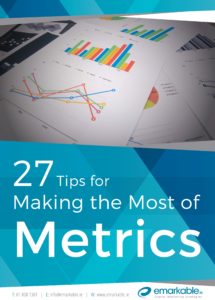Top Tips for Making the Most of Metrics
9 of the 27 Top Tips for Making the Most of Metrics
Rankings in SEO refers to the position of a website in the search engine results pages (SERPs) and play a massive role in SEO and digital marketing strategies. There are several factors that influence how high a website appears on the SERP based on how relevant the page’s content is to the search terms used or the quality of any backlinks pointing to the webpage. Metrics refers to the standard of measurement used to ascertain how well your keywords are performing. Today we’re going to take a look at the top thirty tips you can use to make sure you make the most of your website’s metrics.
- Organic Traffic – this is the purest SEO metric you can track as it shows you clear proof that your SEO efforts are increasing traffic to your website. However, it is important to be aware that the quality of the traffic will depend on which keywords you are ranking for.
- Keyword Rankings – knowing where your target keywords rank is essential for success – you can use tools to do this or do it manually.
- Keep it Short – Google claims that 40% of all searches are triggered by Google Suggest which starts with shorter phrases – this means using short phrases as a starting point for targeting keywords.
- Engagement Metrics – these show how your visitors are engaging with your website and this plays a vital role in how search engines determine your rankings. These Engagement Metrics fall into three categories:
- Bounce Rate – this tracks the number of visitors who leave your website without clicking a link (or even hitting the back button) and is usually expressed as a percentage. A lower bounce rate means better rankings.
- Time on Site – the more time visitors spend on your website, the more likely it is that they like your content and find it relevant and valuable (factors which matter to search engines).
- Pages Per Visit – this is the number of pages on your website that your users visit (on average) before leaving the site.
- Returning Visitors – a high number of visitors returning to your website shows that people like enough to come back for more.
- Direct Traffic – this is the number of visitors who land on your website by typing your URL into the search bar. This means that people remember your website and your brand name. Returning visitors generally spend more time on the website.
If all of this sounds a bit too long-winded or techy for you, then why not get in touch today to see how our team of experts can make the whole thing a lot easier for you and your business?
Download the 27 tips below.






